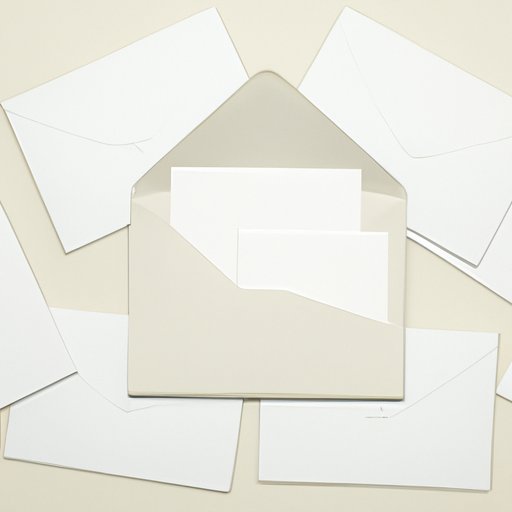I. Introduction
Envelopes are something we use every day, but they don’t always get the attention they deserve. A properly written and addressed envelope can make the difference between a piece of mail that gets delivered promptly and one that gets lost in the mailroom. The purpose of this article is to provide you with a step-by-step guide for writing and addressing envelopes, with etiquette tips, creative ideas, and solutions to common mistakes. This article is intended for anyone who wants to improve their envelope-writing skills or learn something new.
II. Step-by-step guide to writing and addressing an envelope
Before we dive into the guide, it’s important to know the different elements of an envelope. There’s the recipient’s name, address, return address, and postage. Depending on the type of mail you’re sending (letter, postcard, package), formatting requirements may vary. Postal regulations and restrictions are also important to follow. Here’s a step-by-step guide on how to write and address an envelope:
- Start with the return address, which goes in the top left corner of the envelope. Write your full name, address, city, state, and zip code.
- Next, write the recipient’s name in the center of the envelope. Use their full name, including titles or honorifics if appropriate.
- Write the recipient’s street address, followed by their city, state, and zip code on the next line. It’s important to use the correct two-letter state abbreviations.
- Affix the postage in the top right corner of the envelope, making sure it’s the correct amount for the type of mail you’re sending.
III. Etiquette tips for addressing envelopes
Writing and addressing an envelope is not just about formatting and regulations, but also about etiquettes. Here are some tips for addressing envelopes:
- Include appropriate salutations and titles, such as “Mr.,” “Mrs.,” or “Ms.” Avoid using abbreviations whenever possible. Proper gender-neutral terms include “Mx.” or omitting the gendered title.
- Take the time to find out the correct way to address government officials or military personnel. For example, you might address a mayor as “The Honorable Jane Doe.”
- Avoid writing anything on the envelope that might offend the recipient, such as political or religious views.
- Make sure you spell the recipient’s name correctly. If you’re not sure, double-check.
IV. Creative ideas for making an envelope stand out
An envelope doesn’t have to be a plain white envelope. There are plenty of ways to add visual interest and make your mail stand out from the pile. Here are some creative ideas:
- Use calligraphy or a personalized font for the recipient’s name and address.
- Add decorative stickers, stamps, or washi tape to the envelope.
- Create a custom design using your own artwork or photographs. Websites like Canva and Adobe Spark allows you to create custom envelope designs.
V. Common mistakes to avoid when addressing envelopes
Mistakes when addressing envelopes can cause a great deal of inconvenience and delay for the delivery of the mail. Here are some common mistakes and how to avoid them:
- Using incorrect zip codes or forgetting to include them altogether.
- Writing illegibly or using a font that is too small.
- Sending mail without sufficient postage or using the wrong type of postage or stamp.
- Leaving out important information, such as apartment numbers or suite numbers, which can cause the mail to be delivered to the wrong location.
- Using incorrect abbreviations or failing to include necessary titles or honorifics.
VI. Tips for adding personal touches to an envelope
A handwritten note or personal touch can make an envelope feel more special and heartfelt. Here are some tips for adding personal touches to your envelopes:
- Consider using a personalized font or handwriting your return address or recipient’s address.
- Incorporate a special stamp or sticker that reflects your recipient’s interests or hobbies.
- Include a handwritten note inside the envelope.
- Use a unique envelope color, like pastels or brights
VII. FAQ format for addressing common envelope-related questions
Here are answers to some common questions people have about writing and addressing envelopes:
- How do I write an international address?
When writing an international address, start with the recipient’s name, then the street name and number, then the city, province or state, and then the postal code. Finally, include the country name at the bottom of the envelope in all capital letters. - How do I address a same-sex couple?
Address a same-sex couple just like you would any couple. List them in alphabetical order by last name, or choose whichever order feels most appropriate to you. - How should I address an envelope to a military member?
Use the military person’s full name, followed by their rank. Add the unit, APO or FPO address, as well as the nine-digit ZIP code.
VIII. Conclusion
By following these steps and tips, you can increase the chances of your mail arriving on time and make a positive impression on your recipients. Whether you opt for creative design or strictly follow the etiquette, a well-crafted envelope will ensure the success of your mailing. Don’t feel intimidated by the process of writing and addressing envelopes – you have all the knowledge and resources you need to get started.
